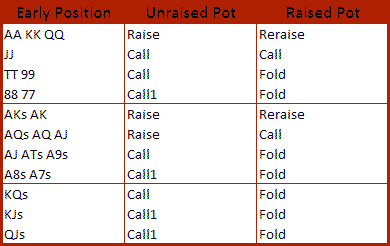
Playing Texas Hold’em from an early position can be a challenge because you are at a positional disadvantage. The information available to you is limited compared to other players who act after you. Therefore, it is crucial to have a sound strategy to navigate the early position successfully.
Early position is considered the first 3 seats after the blinds. These are considered UTG (Under the Gun), which is the first person to act, UTG+1, and UTG+2. In the graphic above, it shows a typical 9 person table, the red circle indicates the three players that are seated in early position labeled Player 1, Player 2, and Player 3.
The hands that are playable from early position are limited, check out our early position hand chart below:
Early Position Hand Chart

Understanding the Early Position Hand Chart
The first column shows you the list of playable hands from early position. Any other hand you are dealt should be instantly folded. The second column indicates whether someone has raised the pot before you. If they have not raised the pot, but limped in, then act on your hand according to the action in the second column. The third column provides your action if the pot has been raised before you. For example, if you are holding KJs in early position, and one person has entered the pot before you but did not raise, then you would call. If two people have entered the pot before you, you would fold. If the pot has been raised before you, you would fold.
Here are some general tips on how to play Texas Hold’em from an early position:
Play Tight: This is the golden rule of playing from an early position. Because so many players act after you, you want to only play your best hands. Hands like high pairs (AA, KK, QQ, JJ, and maybe TT) and big aces (AK, AQ, and maybe AJ) are generally strong enough to open with from an early position.
Understand Hand Strength: Be aware that the value of certain hands goes down when you’re in an early position. For instance, KJ suited might look attractive, but it can get you into trouble from an early position if someone behind you has a hand like AJ or KQ.
Avoid Limping: As a general rule, if your hand is good enough to play, it’s good enough to raise with. By raising, you might take down the blinds uncontested, build a pot for when you have a strong hand, or get heads-up against a single opponent. Limping opens the door for players to come in cheaply, and you’ll find yourself up against multiple opponents with a wide range of hands.
Be Prepared to Fold After the Flop: Even if you start with a good hand, the flop might not improve your hand, or it might look dangerous given the action after the flop. Don’t become overly attached to your hand, and be prepared to let it go if the situation calls for it.
Take Note of Player Tendencies: Be mindful of how the players after you are playing. Are they aggressive, often 3-betting or calling raises, or are they more passive, often folding to raises? This information can help guide your decisions.
Balance Your Range: Despite a tight strategy being advised in early position, occasionally mixing it up with a wider range can keep opponents guessing. Throw in a bluff or semi-bluff with suited connectors or small pairs now and then.
Mind the Stack Sizes: Pay attention to your stack size and those of your opponents. If you or another player has a short stack, the dynamics of what hands you should play can change drastically.
Remember that these are general guidelines and that successful poker strategy depends on adapting to the specific circumstances of each game and each hand. Your strategy should change based on your opponents, your image at the table, and the specific dynamics of the game you’re in.
Leave a Review
Submit your review | |







